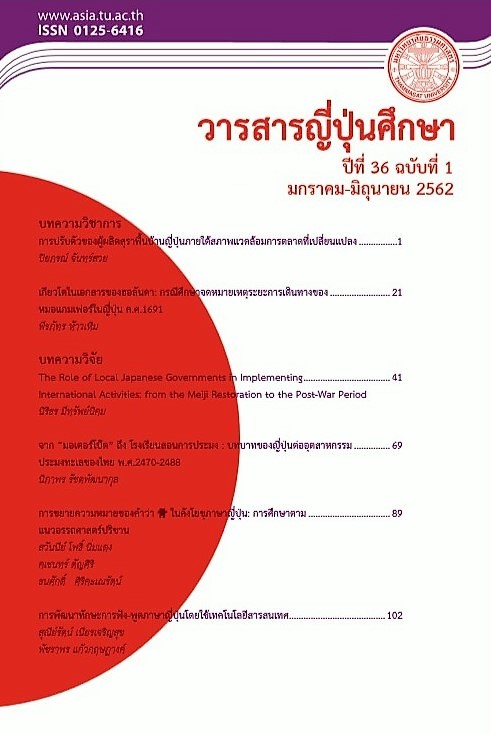การปรับตัวของผู้ผลิตสุราพื้นบ้านญี่ปุ่นภายใต้สภาพแวดล้อมการตลาดที่เปลี่ยนแปลง
คำสำคัญ:
สุราพื้นบ้านญี่ปุ่น, เหล้าสาเก, โชจู, สภาพแวดล้อมทางการตลาด, การปรับตัวของ ผู้ผลิตสุราพื้นบ้านญี่ปุ่นบทคัดย่อ
ตลาดเครื่องดื่มแอลกอฮอล์ในประเทศญี่ปุ่นมีการแข่งขันรุนแรง สุราพื้นบ้านญี่ปุ่นหรือเรียกอีกอย่างว่าสุราแห่งชาติญี่ปุ่น (國酒:kokushu ) อย่างเหล้าสาเก และโชจู เป็นสุราที่รัฐบาลญี่ปุ่นให้ความสำคัญและสนับสนุนนั้นมีปริมาณการบริโภคลดลงเนื่องจากสภาพแวดล้อมทางการตลาดได้เปลี่ยนแปลงไป ทั้งการเปลี่ยนเป็นสังคมผู้สูงอายุ กระแสรักสุขภาพมีมากขึ้น สภาพเศรษฐกิจตกต่ำต่อเนื่องทำให้ประชาชนไม่ค่อยมีการใช้จ่าย วัฒนธรรมการดื่มสุราที่เปลี่ยนแปลงไป โครงสร้างระบบการกระจายสินค้าเปลี่ยนแปลงไป จำนวนโทจิ (杜氏:Touji ) ซึ่งเป็นผู้ควบคุมดูแลการผลิตสุราพื้นบ้านแบบดั้งเดิมมีจำนวนลดลง แต่ภายใต้สภาพแวดล้อมดังกล่าวก็มีผู้ผลิตสุราพื้นบ้านจำนวนไม่น้อยที่ประสบความสำเร็จทางการตลาด ซึ่งผู้ผลิตเหล่านั้นมีการปรับตัวดังนี้ การสร้างความแตกต่างให้กับสินค้า การขยายกลุ่มลูกค้าเป็นวัยรุ่นและผู้หญิง อีกทั้งเปลี่ยนแปลงภาพลักษณ์สินค้าให้เหมาะกับกลุ่มลูกค้าใหม่ การขยายตลาดไปยังต่างประเทศ การเลือกช่องการกระจายสินค้าที่เหมาะสม การนำเที่ยวโรงงานสุรา การสร้างวัฒนธรรมการดื่มสุราแบบใหม่ที่เข้ากับสุราพื้นบ้าน การสร้างความร่วมมือกันระหว่างผู้ผลิตสุราพื้นบ้านในการแลกเปลี่ยนเทคโนโลยีและวัตถุดิบการผลิต
Downloads
เอกสารอ้างอิง
Development Bank of Japan. (2013). Seishugyoukai no genjyou to seichousenryaku. Retrieved October 25, 2018, from https://www.dbj.jp/ja/topics/region/area/files/0000027147_file2.pdf (in Japanese )
Development Bank of Japan. (2017). Atarashii shochujidai- Kaoritakakai purimiashochu to honkakushochu zensensaihokujyou no kanousei. Retrieved October 25, 2018, from https://www.dbj.jp/ja/topics/region/area/files/0000027147_file2.pdf (in Japanese )
Fushimi Sake District :Food and Drink in Kyoto. Retrieved November 16, 2018, from Japan Guide website : https://www.japan-guide.com/e/e3938.html
Gekkeikan. (2018). Gekkeikan Okura Sake Museum. Retrieved November 1, 2018, from http://www.gekkeikan.co.jp/english/kyotofushimi/museum.html
Gekkeikan.(2018). futsushu-ippanshutowa donoyounasakedesuka? tokusen josen kasen no chigai wo oshietekudasai. Retrieved November15,2018, from Gekkeikan shiru-tanoshimu Website : http://www.gekkeikan.co.jp/enjoy/sake/type/type02.html (in Japanese)
Hounichikyaku no hachiwari ga tabi na chikara de 『nihonshu wo nomu 』wo keiken inbaundo de takai kanshin no nihonshu wo katsuyou shita chihoubu de koso ikiru 「nihonshusakagura meguri tsuaa」towa. Retrieved May 24, 2019, from https://honichi.com/news/2017/12/29/shuzotourism/ (in Japanese)
Japanese Sake and Shochu Association. (2018). Let's KAMPAI with Japanese Sake. Retrieved Noverber16, 2018 from http://www.japansake.or.jp/sake/pdf/lets_kampai_2018.pdf
Japan Tourism Agency (2018). nihonsanshurui no yushutsusokushin renrakukaigi shiryousetsumei. Retrieved May 24, 2019, from https://www.cao.go.jp/cool_japan/kaigi/syurui/10/pdf/siryou3-8.pdf (in Japanese)
JETRO. (2013). Efforts to promote Japanese alcoholic drinks to global consumers. Retrieved October 10, 2018, from https://www.jetro.go.jp/ext_images/en/reports/survey/pdf/201301_alcoholic_drink.pdf
Kumasaka Toshihiko. (2016). Seishuseizougyou(chizakemeekaa )no kokusaika no igi to kanousei . Retrieved November 26, 2018, from http://swubizlab.jp/wp/wp-content/uploads/2017/03/2017_004.pdf (in Japanese)
Mitsubishi-UFJ Research & Consulting. (2013). Honkakushochumeekaani motorareru aratanatorikumi -shochushijyou n oshukushoujidai wo mukaete. Retrieved October 25, 2018, from http://www.murc.jp/thinktank/rc/report/consulting_report/cr_130516.pdf (in Japanese)
Mitsubishi-UFJ Research & Consulting. (2017). Nihonshushijyou wo saikousareru tameni. Retrieved October 30, 2018, from http://www.murc.jp/uploads/2012/08/cmc_mc_1610.pdf (in Japanese)
National Tax Agency Japan. (2017). Shuruihambai(shouhi)suuryou no suii. Retrieved November 13, 2018, from https://www.nta.go.jp/taxes/sake/shiori-gaikyo/shiori/2017/pdf/006.pdf (in Japanese)
National Tax Agency Japan. (2018). Sake Repooto. Retrieved November 13, 2018, from https://www.nta.go.jp/taxes/sake/shiori-gaikyo/shiori/2018/pdf/000.pdf (in Japanese)
National Tax Agency Japan (2018). seishuseizougyousha no yushutsugaikyou. Retrieved May 25, 2019, from https://www.nta.go.jp/taxes/sake/yushutsu/seishu_gaikyo/pdf/h28.pdf (in Japanese)
National Tax Agency Japan (2018).「 shurui kourigyousha no gaikyou」ni tsuite (Heisei28 nendobun). Retrieved May 25, 2019, from https://www.nta.go.jp/taxes/sake/yushutsu/seishu_gaikyo/pdf/h28.pdf (in Japanese)
Nihonsakari. (2018).「chiaazubotoru」de kajuaru de osharena shokutaku wo enshutsu . Retrieved November 1, 2018, from http://www.nihonsakari.co.jp/bottle/cheersbottle.html (in Japanese)
Nihonsakari. (2018). Nihonshu ga mottotanoshikunaru-osake wo tanoshimuryouri reshipi . Retrieved November 1, 2018, from http://www.nihonsakari.co.jp/barecipe/index.html (in Japanese)
Nihonshu ga buumu wa hontou desuka? - buumunanoni shouhiryou ga fuenairiyuu. (2017, December). Sakebunkakenkyujo News Letter , (49). Retrieved October 25, 2018 from http://www.sakebunka.co.jp/archive/letter/pdf/letter_vol49.pdf (in Japanese )
Nihonshuzou toujikumiai rengoukai kaiinsuuchou.(2016, February 23). Jyoukai times. Retrieved May 25, 2019, from http://www.jyokai.com/?p=6981 (in Japanese)
Ninomiya Mari. (2009). A Japanese Sake Brewery Making Decisions. Retrieved October 11, 2018, from https://www.researchgate.net/publication/235244931_A_Japanese_Sake_Brewery_Making_Decisions
Record export value & volume in 2017. (2018, February 23). Sake Experience Japan. Retrieved May 25, 2019, from http://sakeexperiencejapan.com/sake-production/record-export-value-volume-in-2017/
Sado to inbaundo. Retrieved May 24, 2019, from https://www.sake-tour.jp/news/201806159jp.html (in Japanese)
Takahashi Murakami Unveils a Custom-Designed Sake Set in Collaboration with NEXT FIVE Breweries . Retrieved November 16, 2018, from https://hypebeast.com/2016/6/takashi-murakami-bar-zingaro-next-five-sake-set
Takarashuzou supaakuringu seishu 「MIO」wa raitoyuuzaa kakutoku ni seikou. (2016, October 17). Nikkangendai DIGITAL. Retrieved May 24, 2019, from https://www.nikkan-gendai.com/articles/view/life/161865 (in Japanese)
Takarashuzou 2020 nen madeni renketsu uriagedaka 2900oku en ijyou mezasu. (2017, June 6). Jyoukai times. Retrieved May 24, 2019, from http://www.jyokai.com/?p=7837 (in Japanese)
Takarashuzou. (2018) . MIO WEB gentei muubii . Retrieved November 1, 2018, from http://www.shirakabegura-mio.jp/video/(in Japanese)
Takarashuzou. (2018). MIO Recipe . Retrieved November 1, 2018, from http://www.shirakabegura-mio.jp/recipe/ (in Japanese)
Yoshida Kaoru. (2016). Nihonshugyoukai no genjyou to kadai. Retrieved October 30, 2018, from SPEEDA Website : https://jp.ub-speeda.com/analysis/archive/73/(in Japanese)




